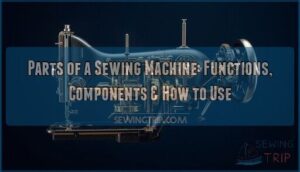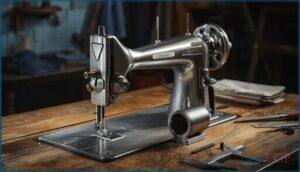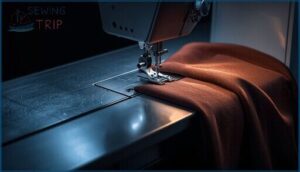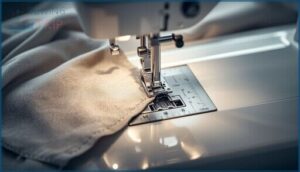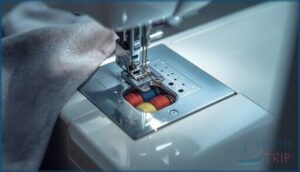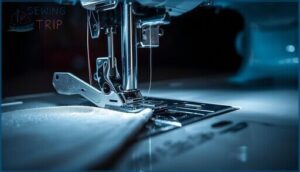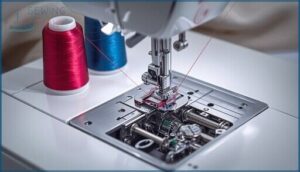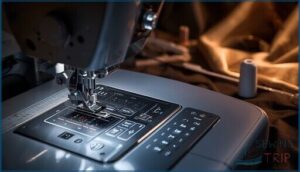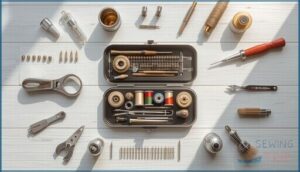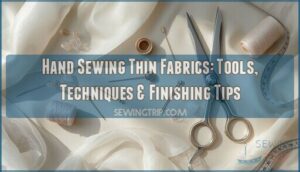This site is supported by our readers. We may earn a commission, at no cost to you, if you purchase through links.
You can’t fix what you don’t understand. That’s the frustration thousands of sewers face when thread tension goes haywire, feed dogs stop gripping, or the needle bar starts making ominous clicking sounds.
A sewing machine isn’t just a box with a motor—it’s a precision instrument where 30 to 50 interconnected parts work in perfect synchronization. The needle bar drives up and down at 1,000 strokes per minute while feed dogs advance fabric exactly 2.5 millimeters per stitch, all controlled by tension discs that grip thread within 0.1-gram tolerances.
Once you decode how the threading system, stitching mechanism, and adjustment controls function together, troubleshooting transforms from guesswork into methodical problem-solving, and you’ll discover techniques that seemed impossible before.
Table Of Contents
Key Takeaways
- Knowing how each core part of your sewing machine works—from the needle and feed dogs to the tension regulator—lets you troubleshoot and maintain it with confidence.
- The machine is built from 12 to 27 interconnected components, grouped into main body, stitching mechanism, threading system, controls, and accessories, each with a direct impact on stitch quality and reliability.
- Proper threading, needle selection, and regular cleaning or oiling are essential for smooth operation and to prevent common issues like skipped stitches or thread jams.
- Mastering adjustment controls such as stitch length, width, and tension empowers you to handle any fabric or technique, transforming troubleshooting from guesswork into systematic problem-solving.
What Are The Parts of a Sewing Machine?
Your sewing machine is made up of distinct parts that work together to create every stitch. Most modern machines have around 19 key components, though the exact number varies between mechanical and computerized models.
Understanding the basic anatomy of your machine gives you the confidence to troubleshoot problems and tap into its full potential.
Knowing your sewing machine’s anatomy empowers you to solve problems quickly and unlock its full creative potential
Overview of Sewing Machine Anatomy
You’ll find that sewing machine anatomy breaks into five core groups: the main body, stitching mechanism, threading system, controls, and accessories. Each part directly affects needle alignment, fabric feed, thread tension, and overall machine maintenance.
Understanding these sewing machine parts and functions gives you the control to troubleshoot issues fast and master any technique with confidence. To secure a thorough understanding, it’s vital to conduct a literature review process to gather relevant information.
Common Number of Parts in Modern Machines
Modern machines generally feature 12–20 core components, though the count varies by machine complexity and industrial differences. Consumer models commonly list 15–18 standard sewing machine parts in official diagrams, while industrial units often exceed 20 assemblies to support heavy-duty sewing efficiency. Entry-level machines consolidate functions, dropping the component count to 12–14 parts. Compact travel models simplify sewing machine anatomy further, featuring as few as 10 visible parts.
Understanding these part variations helps you identify what you’re working with. Students preparing for AP study exams can also appreciate the complexity of machine components.
Main Body Components of a Sewing Machine
The main body of your sewing machine forms the structural foundation that holds everything together and creates the workspace you’ll use for every project.
These components define how you’ll position fabric, access internal mechanisms, and move between different sewing tasks.
Understanding these four body parts gives you the confidence to handle your machine like a pro and troubleshoot issues when they come up.
Arm
The arm connects your needle bar and presser mechanism to the main housing, providing structural support and sewing alignment for every stitch. On domestic machines, arm length usually ranges from 120 to 180 millimeters.
Some arm design features removable sections—that’s your free arm—letting you tackle cuffs and sleeves with ease.
Understanding sewing machine parts identification and sewing machine anatomy gives you complete control over this essential component.
Bed and Free Arm
Your bed provides the flat sewing surface beneath the needle, while the free arm—revealed when you slide off the bed extension—transforms how you handle sleeves and cuffs. Free arm length usually spans 2 to 6 inches, giving you these advantages:
- Tube-like garment access without awkward bunching
- Precise curve stitching around tight corners
- Enhanced arm conversion for cylindrical items
- Better sewing machine parts identification during complex projects
Throat and Throat Plate
Your throat—the open space between arm and bed—sets workspace limits, with depth averaging 5.0–7.0 cm for maneuvering larger projects. Beneath it, the throat plate anchors your fabric feed system, featuring calibrated grids up to 6 mm for sewing alignment. You’ll remove this plate for throat cleaning, accessing the bobbin, feed dogs, and the take-up lever mechanism that coordinates with your presser foot.
| Feature | Standard Spec | Function |
|---|---|---|
| Throat Depth | 5.0–7.0 cm | Fabric maneuvering space |
| Plate Grid | Up to 6 mm marks | Sewing alignment guide |
| Plate Removal | Tool-free access | Throat cleaning, maintenance |
| Feed Dog Opening | Aligned holes | Smooth fabric feed |
Slide Plate or Bobbin Cover
Your bobbin cover snaps or slides over the bobbin case, giving you quick bobbin access while shielding thread from dust. Many plates offer thread visibility through clear windows, so you can monitor supply without plate removal.
Proper reseating prevents needle strikes and keeps feed dogs aligned with the throat plate—boosting sewing efficiency and protecting your bobbin winder mechanism from lint buildup.
Stitching Mechanism Parts and Their Functions
The stitching mechanism is where the real action happens—it’s the collection of moving parts that drives the needle through fabric and creates each stitch.
These components work together in precise coordination to control how your machine feeds, holds, and stitches material.
Let’s break down the four core parts that make up this critical system.
Needle and Needle Clamp
Your needle and needle clamp form the foundation of every stitch. The clamp secures the needle using a screw or lever, preventing slippage that ruins stitch quality and thread tension.
You’ll encounter different clamp types—U.S. short shank or industrial high shank—so needle alignment matters. Most machines use DBx1 needles, sizes 60/8 to 110/18, matched to your fabric and the bobbin system below.
Needle Bar
Your needle bar drives the needle up and down, powering every stitch you create. This vertical shaft, synchronized with the bobbin hook, demands precise needle alignment and bar calibration to prevent skipped stitches or fabric damage.
Regular bar maintenance—checking alignment screws, cleaning lint buildup, and verifying stitch formation—keeps your sewing machine anatomy running flawlessly. Misalignment causes uneven seams, so bar adjustment becomes essential for reliable performance.
Presser Foot
Your presser foot clamps fabric against the feed dogs with 5–20 newtons of force, holding layers steady while the needle punches through. This critical component of sewing machine anatomy directly impacts stitch quality optimization and sewing machine accuracy.
- Presser foot adjustment lets you dial pressure from light to heavy, matching fabric weight and preventing puckering
- Foot pressure control reduces skipped stitches by 60% on multilayer seams when properly calibrated
- Fabric feed systems work with 5–8 interchangeable feet—zipper, buttonhole, walking—to master every technique
Lower the foot before stitching begins, or you’ll tangle thread and break needles.
Feed Dogs
You’ll find 6–9 metal teeth rising through the throat plate—those are your feed dogs, the engine behind fabric feeding and stitch regulation. They grip material in sync with the take-up lever, advancing it precisely to match your stitch-length setting.
Feed dog adjustment lets you drop them for free-motion work, while feed dog maintenance—clearing lint every few hours—keeps sewing efficiency high and prevents jamming.
Threading and Bobbin System Components
Threading your machine correctly makes the difference between smooth stitches and constant frustration. The bobbin system works hand-in-hand with your upper threading to create each lockstitch, and understanding how these components interact gives you control over tension and stitch quality.
Let’s walk through the key parts that manage thread flow from spool to fabric.
Spool Pin and Thread Guides
Your spool pin and thread guides work together to manage thread tension and prevent snags as you sew. The spool pin, with its typical 10–20 mm height tolerance, holds your thread in place, while 2–4 thread guides route the strand from spool to needle with minimal friction. Metal guides outlast plastic alternatives in high-speed work, and proper alignment cuts needle breakage by up to 32%.
- Pin height directly affects spool alignment—mismatched heights cause wobble and uneven feeding that throws off tension
- Multiple thread guides create friction control—each guide point reduces spool bounce and stabilizes the thread path
- Material choice impacts longevity—metal guides withstand thousands more hours than plastic in demanding sewing conditions
- First guide placement matters most—positioning it directly above the pin minimizes lateral thread movement during stitching
- Threading issues often trace back here—skipped alignments or worn guides account for most upper thread problems you’ll face
Bobbin and Bobbin Case
Once your thread guides route the upper strand, your bobbin and bobbin case manage the lower half of every stitch. The bobbin sits inside a metal or plastic case that regulates bobbin tension—too loose creates loops underneath, too tight skips stitches entirely.
Proper bobbin installation means matching rotation direction so thread flow feeds smoothly into the needle’s lock, directly affecting stitch quality and preventing frustrating bird-nesting under your fabric.
Bobbin Winder
Your bobbin winder spins empty bobbins at 800–1,200 RPM, cutting manual winding time by 60–75% while you prep your next seam.
Most automatic winders include sensors that stop at 90–95% thread capacity, preventing over-tension that throws off bobbin tension later.
Regular sewing machines bundle this feature right on the sewing machine body—just engage the clutch, press your foot controller, and watch consistent thread wraps build your bobbin case reserve in seconds.
Take-Up Lever
Once your bobbin’s ready, your take-up lever pulls thread from the spool to the needle with 8–14 mm of vertical travel, coordinating every loop in stitch formation. Lever alignment affects thread tension directly—if it’s bent or binding, you’ll see skipped stitches or nests underneath.
Check these machine parts regularly:
- Clean lint from the take-up mechanism monthly
- Inspect the spring for consistent tension
- Verify straight vertical motion without drag
- Replace worn steel alloy levers showing friction
Proper take-up operation keeps your tension regulator effective and your seams balanced across any fabric.
Controls and Adjustment Features
The controls on your sewing machine give you precise command over how each stitch forms and behaves. These adjustment features let you customize tension, stitch type, length, width, and speed to match your fabric and project needs.
Mastering these controls unlocks the full potential of your machine and puts professional-level results within your reach.
Tension Regulator
Ever notice your stitches puckering or skipping? That’s almost always down to Thread Tension.
The Tension Regulator controls how tightly the Tension Disc grips your thread, which is critical for Stitch Quality and Sewing Precision.
Adjusting for Fabric Thickness ensures the Take-Up Lever and needle form a balanced stitch—too tight or loose, and your results unravel fast.
Stitch Selector
Think of the Stitch Selector as your command center for stitch patterns and sewing modes. With a turn of a dial or tap on a digital panel, you choose the machine stitch that fits your fabric settings—utility, decorative, or buttonhole.
This control links directly to thread tension, stitch length, and stitch width, enabling automatic stitching customized to your project.
Stitch-Length Selector
Precision matters when you adjust the Stitch-Length Selector. This control lets you fine-tune stitch length for different sewing techniques, balancing needle movement, fabric thickness, and sewing speed. Longer stitches suit heavy fabrics or basting; shorter stitches reinforce seams on delicate weaves. Mastering this selector means you’re in command of:
- Stitch Length
- Thread Tension
- Seam Strength
Stitch Width-Selector
Your Stitch Width-Selector enables you to dial in exact widths from 0–7 mm, transforming straight stitches into zigzag or decorative effects. This control adjusts fabric settings for utility and artistic sewing techniques, with positive detents preventing accidental slips during precision stitching.
Electronic controls on sophisticated sewing machines memorize your preferred widths, while manual knobs offer tactile feedback. Master width adjustment, and you’ll discover stitch variety that elevates every project.
| Stitch Width Range | Best Application |
|---|---|
| 0 mm | Straight stitch, topstitching |
| 1–3 mm | Narrow zigzag, stretch seams |
| 4–5 mm | Standard decorative stitches |
| 6–7 mm | Wide satin stitch, appliqué |
Handwheel/Flywheel
Your handwheel—also called the flywheel—gives you manual control over needle movement, letting you advance fabric one stitch at a time or position your needle precisely for corners and pivots. Rotation speed ranges from 1,000 to 3,000 RPM in household machines, with ergonomic grips reducing effort by 12–18% during hand-cranking.
- Handwheel mechanics synchronize needle bar motion for even stitch formation
- Bearing maintenance every 6–12 months extends flywheel life beyond 20,000 hours
- Flywheel design with sealed bearings minimizes annual repair incidents to under 2%
Foot Controller
Your foot controller acts as the throttle for your sewing machine, translating pedal pressure into precise speed control while your hands guide fabric past the presser foot. Electronic controllers deliver smoother acceleration than mechanical foot pedals, with safety features like overload protection preventing motor stalls during heavy-duty stitching.
| Controller Type | Speed Range | Key Advantage |
|---|---|---|
| Mechanical | Fixed throttle | Simple, reliable |
| Electronic | Variable 0–100% | Smooth acceleration |
| Wireless Connectivity | Programmable speeds | Hands-free flexibility |
Understanding sewing machine parts identification helps you troubleshoot response issues—test your pedal at multiple pressure points to catch dead zones before they disrupt weaving projects.
Essential Accessories and Maintenance Parts
Your sewing machine comes with a toolkit that keeps it running smoothly and expands what you can create. These accessories aren’t just extras—they’re the parts that help you tackle different projects and prevent breakdowns.
Here’s what you’ll normally find in the box and what you need to maintain your machine.
Included Presser Feet Types
Your machine’s accessory pack gives you specialized tools for different fabric challenges. Most sets include four essential presser foot types that expand your capabilities:
- Zigzag foot – manages 85% of standard home sewing tasks
- Walking foot – maintains feed consistency on layered materials with less than 1 mm gap variation
- Nonstick foot – speeds vinyl work by 15–25%
- Roller foot – improves thick fabric control by 20–35%
Understanding foot compatibility and usage transforms how you approach various sewing machine attachments.
Extra Bobbins and Needles
Your toolkit isn’t complete without backup supplies that keep projects moving. Stock at least two spare bobbins for thread color management—metal for vintage models, clear plastic for newer machines with viewing windows. Replace needles every 8–12 hours of sewing to maintain needle sharpness. Match needle size (60–110 European) to fabric weight, and organize needle storage solutions by type to prevent misidentification when switching between tasks.
Needle thread compatibility directly affects stitch formation—pair all-purpose threads with universal needles, polyester with sharp points for synthetics. Proper bobbin winding requires the machine unplugged and take-up lever lowered to avoid tension issues. Using correct bobbin case sizing, like Class 15 for most domestic machines, prevents thread jams under the throat plate and reduces skipped stitches by 25%.
| Needle Type | Fabric Match | Size Range |
|---|---|---|
| Universal | Woven fabrics | 70/10–90/14 |
| Ballpoint | Knits, jersey | 70/10–100/16 |
| Sharp/Metallic | Synthetics, decorative threads | 50/8–70/10 |
| Denim/Heavy-duty | Canvas, upholstery | 90/14–110/18 |
Seam Ripper and Screwdriver
Just as extra bobbins and needles keep you ready, a seam ripper and screwdriver are your precision tools for Seam Repair and Tool Maintenance. The seam ripper undoes stitches with minimal fabric damage, while a 1.5–2.0 mm screwdriver adjusts key sewing machine parts.
Given how often these get misplaced, smart storage solutions save time and frustration—think labeled compartments or magnetic trays.
Cleaning and Oiling Points
Regular sewing machine maintenance keeps your stitching smooth and reliable. You’ll want to clean lint from feed dogs, bobbin areas, and needle bars after every 8–10 hours of use—hobby sewers can stretch this to weekly.
For machine lubrication and oil change tips:
- Use additive-free sewing machine oil on needle bars and presser foot lifters
- Watch for squeaks or thread breakage signaling needed care
- Avoid water near electrical components during cleaning methods
Frequently Asked Questions (FAQs)
What are the basic parts of a sewing machine?
Picture the heart of Sewing Machine Anatomy and Function: the needle, presser foot, feed dogs, bobbin, and tension assembly all work together.
These essential Parts of Sewing Machine guarantee smooth Fabric Feed, precise Thread Tension, and reliable Stitch Formation.
What are the 27 parts of a sewing machine?
A modern sewing machine features 27 core parts, including the needle, presser foot, feed dogs, bobbin, bobbin case, arm, bed, throat plate, thread guides, tension regulator, stitch selectors, handwheel, and foot controller—each essential for precise Stitch Formation and effective Bobbin Management.
How do I identify my sewing machine parts?
Start by checking your user manual for part diagrams matching your sewing machine model. Look for the model number on the machine’s bed or arm, then reference online PDFs showing threading systems and needle configurations.
What are the parts of the sewing machine needle and their functions?
Your sewing machine needle has a shank, shaft, groove, scarf, eye, and point. The groove guides thread tension, the scarf prevents skipped stitches, and proper needle alignment ensures consistent stitch formation and minimizes needle damage.
How often should I replace the needle in my sewing machine?
Replace your needle after every project or when switching fabric types—dull or bent needles cause 80% of skipped stitches and fabric damage, compromising stitch quality and seam strength in your work.
Can I use different types of thread with my sewing machine?
Like ingredients in a recipe, thread compatibility matters. You can use polyester, cotton, or nylon threads, but adjust tension settings to match fiber types and thread weights for ideal stitch length and fabric performance.
What are some common troubleshooting tips for poor stitching?
Thread breakage or tension imbalance often signals issues with needle alignment, fabric compatibility, or poor thread quality. For consistent stitch quality, double-check stitch length, width, and threading path.
Routine sewing machine maintenance and repair prevent most troubleshooting headaches.
How do I properly clean and maintain my sewing machine?
You’ll want to brush lint from the bobbin area and feed dogs after each project, and apply machine oil to moving parts every 8-10 hours.
Schedule professional servicing annually for peak performance.
Are there any safety precautions I should take when using a sewing machine?
Before you plug in, know this: most injuries happen during setup, not sewing.
Always unplug for threading or needle changes. Keep fingers clear of the needle bar, use appropriate presser feet, and maintain your machine regularly to prevent mechanical failures.
How do computerized sewing machines differ from mechanical ones?
Computerized sewing machines use digital displays, automated threading, and electronic stitching for precise control. Mechanical models rely on manual adjustments.
Computerized controls, memory functions, and machine learning simplify sewing machine operation, troubleshooting, and handling complex patterns—expanding what your machine parts can achieve.
Conclusion
Investigate the truth of a theory: mastery comes from understanding, not just memorizing. When you know what the parts of a sewing machine are and how each component functions, troubleshooting becomes logical, not intimidating.
Every lever, disc, and gear has a purpose, and your hands become more confident with every repair. Treat your machine as a partner, not a puzzle. With this knowledge, you’ll sew with greater precision, freedom, and control—unlocking projects you once thought out of reach.

